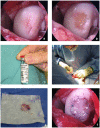Joint Preservation Techniques in Orthopaedic Surgery
- PMID: 28632455
- PMCID: PMC5665111
- DOI: 10.1177/1941738117712203
Joint Preservation Techniques in Orthopaedic Surgery
Abstract
Context: With increasing life expectancy, there is growing demand for preservation of native articular cartilage to delay joint arthroplasties, especially in younger, active patients. Damage to the hyaline cartilage of a joint has a limited intrinsic capacity to heal. This can lead to accelerated degeneration of the joint and early-onset osteoarthritis. Treatment in the past was limited, however, and surgical treatment options continue to evolve that may allow restoration of the natural biology of the articular cartilage. This article reviews the most current literature with regard to indications, techniques, and outcomes of these restorative procedures.
Evidence acquisition: MEDLINE and PubMed searches relevant to the topic were performed for articles published between 1995 and 2016. Older articles were used for historical reference. This paper places emphasis on evidence published within the past 5 years.
Study design: Clinical review.
Level of evidence: Level 4.
Results: Autologous chondrocyte implantation and osteochondral allografts (OCAs) for the treatment of articular cartilage injury allow restoration of hyaline cartilage to the joint surface, which is advantageous over options such as microfracture, which heal with less favorable fibrocartilage. Studies show that these techniques are useful for larger chondral defects where there is no alternative. Additionally, meniscal transplantation can be a valuable isolated or adjunctive procedure to prolong the health of the articular surface.
Conclusion: Newer techniques such as autologous chondrocyte implantation and OCAs may safely produce encouraging outcomes in joint preservation.
Keywords: articular cartilage; autologous chondrocyte implantation; meniscal transplantation; osteochondral allograft.
Conflict of interest statement
The following author declared potential conflicts of interest: Armando F. Vidal, MD, is a paid consultant for Arthrocare and Stryker and has been a paid presenter for Arthrex, Inc, and Ceterix.
Figures






References
-
- Abat F, Gelber PE, Erquicia JI, Pelfort X, Gonzalez-Lucena G, Monllau JC. Suture-only fixation technique leads to a higher degree of extrusion than bony fixation in meniscal allograft transplantation. Am J Sports Med. 2012;40:1591-1596. - PubMed
-
- Bae DK, Yoon KH, Song SJ. Cartilage healing after microfracture in osteoarthritic knees. Arthroscopy. 2006;22:367-374. - PubMed
-
- Ball ST, Amiel D, Williams SK, et al. The effects of storage on fresh human osteochondral allografts. Clin Orthop Relat Res. 2004;418:246-252. - PubMed
-
- Bartlett W, Skinner JA, Gooding CR, et al. Autologous chondrocyte implantation versus matrix-induced autologous chondrocyte implantation for osteochondral defects of the knee: a prospective, randomised study. J Bone Joint Surg Br. 2005;87:640-645. - PubMed
Publication types
MeSH terms
LinkOut - more resources
Full Text Sources
Other Literature Sources
Research Materials
Miscellaneous

